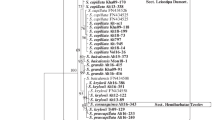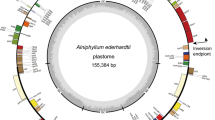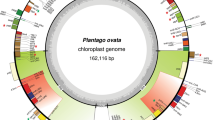Abstract
The use of insertion/deletion (indel) patterns from sequences of the trnL intron and trnL–F intergenic spacer (IGS) in finding plastid genome types of the genus Poa L. was studied. New sequences for 23 taxa (P. alpina, P. badensis, P. bulbosa, P. crassipes, P. molinerii, P. annua, P. chaixii, P. granitica, P. pratensis, P. sibirica, P. remota, P. botryoides, P. cenisia, P. compressa, P. laxa, P. margilicola, P. media, P. nemoralis, P. palustris, P. pannonica, P. pirinica, P. riphaea, and P. sejuncta) and 18 previously published sequences, which represent 11 of the 13 sections listed for Poa in Flora Europaea, were investigated. Collections were made primarily in central Europe. Indel patterns, despite sampling less than 0.7% of the plastid genome, produced four taxa groupings that were congruent with the major divisions obtained in intensive, previously published restriction-site studies. Insertion/deletion events in the trnL intron and trnL–trnF IGS were in nearly all cases unique to a single pattern group and thus provided almost no information about relationships among these groups. Indels did, however, provide a meaningful infrageneric classification criterion for Poa. They can serve as useful tools in studying relationships within this genus.





Similar content being viewed by others
References
Ascherson P, Graebner P (1898–1902) Synopsis der mitteleuropäischen Flora, vol 2/1. Wilhelm Engelmann, Leipzig
Baldridge DE, Lohmiller RG (eds) (1990) Kentucky bluegrass (Poa pratensis). In: MT Interagency Plant Materials Handbook for Forage Production, Conservation, Reclamation and Wildlife. Montana State Univ Extension Service Ext Bull 69:38–39
Bernátová D, Májovský J (1997) The Poa glauca group in the Western Carpathians I.: Poa margilicola sp. nova. Biologia, Bratislava 52:27–31
Bernátová D, Májovský J, Obuch J (1999) The Poa glauca group in the western Carpathians II.: Poa sejuncta sp. nova and Poa babiogorensis sp. nova. Biologia, Bratislava 54:37–41
Brysting AK, Holst-Jensen A, Leitch I (2000) Genomic origin and organization of the hybrid Poa jemtlandica (Poaceae) verified by genomic in situ hybridization and chloroplast DNA sequences. Ann Bot 85:439–445, 10.1006/anbo.1999.1088
Brysting AK, Fay MF, Leitch IJ, Aiken SG (2004) One or more species in the arctic grass genus Dupontia?—a contribution to the Panarctic Flora project. Taxon 53:365–382
Catalán P, Torrecilla P, López Rodríguez JA, Olmstead RG (2004) Phylogeny of the festucoid grasses of subtribe Loliinae and allies (Poeae, Pooideae) inferred from ITS and trnL–F sequences. Mol Phylogenet Evol 31:517–541, 10.1016/j.ympev.2003.08.025
Clayton WD, Renvoize SA (1986) Genera Graminum, grasses of the world. Kew Bull Additional Series XIII
Cobb BD, Clarkson JM (1994) A simple procedure for optimising the polymerase chain reaction (PCR) using modified Taguchi methods. Nucleic Acids Res 22:3801–3805
Doust AN, Kellogg EA (2002) Inflorescence diversification in the Panicoid “bristle grass” clade (Paniceae, Poaceae): evidence from molecular phylogenies and developmental morphology. Am J Bot 89:1203–1222
Edmondson JR (1980) Poa L. In: Tutin TG, Heywood VH, Burges NA, Moore DM, Valentine DH, Walters SM, Webb DA (eds) Flora Europaea, vol 5. Cambridge University Press, Cambridge, pp 159–167
Espelund M, Bekele E, Holst-Jensen A, Jakobsen K, Nordal I (1999) A molecular genetic analysis of Eragrostis tef (Zucc.) Trotter: non-coding regions of cpDNA, 18S rDNA and the transcription factor VP1. Section of Feed and Food Microbiology, National Veterinary Institute, Oslo (Norway), NCBI Entrez Nucleotides database, http://www.ncbi.nlm.nih.gov/entrez/query.fcgi?db=Nucleotide (June 24, 2004)
Felsenstein J (1985) Confidence limits on phylogenies: an approach using the bootstrap. Evolution 39:783–791
Felsenstein J (2004) PHYLIP (Phylogeny Inference Package) version 3.6b. Distributed by the author. Department of Genome Sciences, University of Washington, Seattle http://evolution.genetics.washington.edu/phylip.html
Gillespie LJ, Boles R (2001) Phylogenetic relationships and infraspecific variation in Canadian Arctic Poa based on chloroplast DNA restriction site data. Can J Bot 79:679–701, 10.1139/cjb-79-6-679
Gillespie LJ, Soreng RJ (2005) A phylogenetic analysis of the bluegrass genus Poa based on cpDNA restriction site data. Syst Bot 30 (in press)
Giribet G, Wheeler WC (1999) On gaps. Mol Phylogenet Evol 13:132–143
Golenberg EM, Clegg MT, Durbin ML, Doebley J, Ma DP (1993) Evolution of a noncoding region of the chloroplast genome. Mol Phylogenet Evol 2:52–64
Hartley W (1961) Studies on the origin, evolution, and distribution of the Gramineae. IV. The genus Poa L. Aust J Bot 9:152–161
Hodkinson TR, Chase MW, Lledó MD, Salamin N, Renvoize SA (2002a) Phylogenetics of Miscanthus, Saccharum and related genera (Saccharinae, Andropogoneae, Poaceae) based on DNA sequences from ITS nuclear ribosomal DNA and plastid trnL intron and trnL–F intergenic spacers. J Plant Res 115:381–392, 10.1007/s10265-002-0049-3
Hodkinson TR, Chase MW, Takahashi C, Leitch IJ, Bennett MD, Renvoize SA (2002b) The use of DNA sequencing (ITS and trnL–F), AFLP, and fluorescent in situ hybridization to study allopolyploid Miscanthus (Poaceae). Am J Bot 89:279–286
Jirásek V (1934) Poa laxa Haenke subsp. riphaea (Fritsch) Asch.—Graeb. na Babia Góře a Lipt. Holích. Věda Přírodní 15:249–250
Jirásek V (1935) Systematické rozčlenění a klíč k určování československých lipnic (Poa L.) Věstník Královské České Společnosti Nauk 2:1–34
Kelchner SA (2000) The evolution of non-coding chloroplast DNA and its application in plant systematics. Ann Mo Bot Gard 87:482–498
Kelchner SA, Wendel JF (1996) Hairpins create minute inversions in non-coding regions of chloroplast DNA. Curr Genet 30:259–262
Klatte DH (1996) ABIView. Version 1.0
Levinson G, Gutman GA (1987) Slipped-strand mispairing: a major mechanism for DNA sequence evolution. Mol Biol Evol 4:203–221
Mason-Gamer RJ, Orme NL, Anderson CM (2002) Phylogenetic analysis of North American Elymus and the monogenomic Triticeae (Poaceae) using three chloroplast DNA data sets. Genome 45:991–1002, 10.1139/G02-065
Morton BR (1995) Neighboring base composition and transversion/transition bias in a comparison of rice and maize chloroplast noncoding regions. Proc Natl Acad Sci USA 92:9717–9721
Nicora EG (1978) Poa L. In: Nicora EG, DePaula ME, Faggi AM, del C. Mariano M, Miante Alsogaray AM, Parodi LR, Petetin CA, Roig FA, Rúgolo de Agrasar Z (eds) Flora Patagónica, vol 3. Instituto Nacional de Tecnología Agropecuaria, Buenos Aires, pp 138–207
OECD (2003) List of varieties eligible for seed certification—2003/2004. OECD, Paris, http://www.oecd.org/dataoecd/25/39/21648351.pdf
Page RDM (1996) TreeView: an application to display phylogenetic trees on personal computers. Computer Appl Biosci 12:357–358, http://taxonomy.zoology.gla.ac.uk/rod/treeview.html
Ridgway KP, Duck JM, Young JPW (2003) Identification of roots from grass swards using PCR-RFLP and FFLP of the plastid trnL (UAA) intron. BMC Ecol 3:8
Sang T, Crawford DJ, Stuessy TF (1997) Chloroplast DNA phylogeny, reticulate evolution, and biogeography of Paeonia (Paeoniaceae). Am J Bot 84:1120–1136
Soreng RJ (1990) Chloroplast-DNA phylogenetics and biogeography in a reticulating group: study in Poa (Poaceae). Am J Bot 77:1383–1400
Šourek J (1959) Poa crassipes Domin sp. n. a Poa pratensis L. ssp. eupratensis Hayek var. corcontica Domin var. n. Preslia 31:284–286
Stoike LL, Sears BB (1998) Plastome mutator-induced alterations arise in Oenothera chloroplast DNA through template slippage. Genetics 149:347–353
Taberlet P, Gielly L, Pautou G, Bouvet J (1991) Universal primers for amplification of three non-coding regions of chloroplast DNA. Plant Mol Biol 17:1105–1109
Tatusova TA, Madden TL (1999) BLAST 2 Sequences, a new tool for comparing protein and nucleotide sequences. FEMS Microbiol Lett 174:247–250
Thompson JD, Gibson TJ, Plewniak F, Jeanmougin F, Higgins DG (1997) The CLUSTAL_X windows interface: flexible strategies for multiple sequence alignment aided by quality analysis tools. Nucleic Acids Res 25:4876–4882, http://www-igbmc.u-strasbg.fr/BioInfo/ClustalX/Top.html
Torrecilla P, Catalán P (2002) Phylogenetic relationships of Vulpia, the fine-leaved Festuca, and other related genera (Psilurus, Micropyrum, Wangenheimia, Ctenopsis, Narduroides, Cutandia) of the grass tribe Poeae based on simultaneous analysis of nuclear ITS and chloroplast trnL–F sequences. Agricultura y Economia Agraria, Universidad de Zaragoza (Spain). NCBI Entrez Nucleotides database, http://www.ncbi.nlm.nih.gov/entrez/query.fcgi?db=Nucleotide(June 24, 2004)
Torrecilla P, López Rodríguez JA, Stancik D, Catalán P (2003) Systematics of Festuca L. sects. Eskia Willk., Pseudatropis Kriv., Amphigenes (Janka) Tzvel., Pseudoscariosa Kriv. and Scariosae Hack. based on analysis of morphological characters and DNA sequences. Plant Syst Evol 239:113–139, 10.1007/s00606-002-0265-2
Tzvelev NN (1976) Zlaki SSSR. Nauka, Leningrad
Verboom GA, Linder HP, Stock WD (2003) Phylogenetics of the grass genus Ehrharta: evidence for radiation in the summer-arid zone of the South African Cape. Evolution 57:1008–1021
Zuker M (2003) Mfold web server for nucleic acid folding and hybridization prediction. Nucleic Acids Res 31:3406–3415, 10.1093/nar/gkg595
Acknowledgements
The authors wish to thank R.J. Soreng for checking the determination of many of the specimens used in this study and for helpful comments; L.J. Gillespie for helpful comments and advice and for kindly providing a copy of the Gillespie and Soreng manuscript; T.R. Hodkinson and one anonymous reviewer for constructive comments; D. Bernátová, M. Burešová, M. Chytrý, V. Grulich, J.A. Holt, M. Kočí, I. Kuželová, S.L. Thatcher, C. Yankov, and L. Yankova for assisting with field collections; Y. Wang, R. Ma, and X. Chen for providing material from China; J.A. Holt for writing the computer program Invert and editing the manuscript; and J. Janeček and V. Černoch of the Plant Breeding Station Hladké Životice for providing the four commercial cultivars for sequencing. This research was funded by the Ministry of Education of the Czech Republic [material and sequencing with FRVŠ Project 556-G4 (Phylogenetic analysis of Poa L. on the basis of non-coding cpDNA sequences) and equipment with Research Project MSM 143100010 (Spatial and Temporal Biodiversity Dynamics in Ecosystems of Central Europe)]. This research was undertaken within the graduate studies of S.D.S.H., which were supported by a National Science Foundation Graduate Research Fellowship, a US Student Fulbright Grant, and an Honor Society of Phi Kappa Phi Fellowship.
Author information
Authors and Affiliations
Corresponding author
Rights and permissions
About this article
Cite this article
Stoneberg Holt, S.D., Horová, L. & Bureš, P. Indel patterns of the plastid DNA trnL–trnF region within the genus Poa (Poaceae). J Plant Res 117, 393–407 (2004). https://doi.org/10.1007/s10265-004-0172-4
Received:
Accepted:
Published:
Issue Date:
DOI: https://doi.org/10.1007/s10265-004-0172-4




